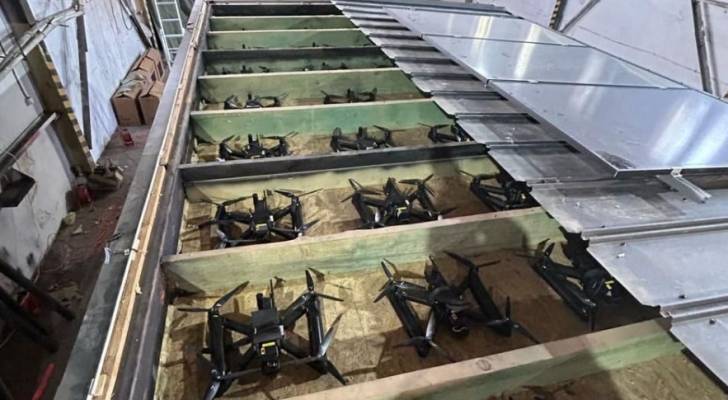Ukrainian military drones (Credit: Security Service of Ukraine)
How did Ukraine manage to sneak 117 drones into Russian territory?
Ukrainian officials have announced what they describe as the most extensive long-range strike operation of the ongoing war with Russia, targeting key military airbases and causing substantial damage to strategic aircraft.
According to President Volodymyr Zelenskyy, the Ukrainian Security Service (SBU) coordinated a complex attack, dubbed "Spider’s Web," involving 117 drones aimed at four Russian airfields. The drones reportedly struck approximately 34 percent of Russia’s strategic cruise missile carriers. The president praised the SBU's chief, Vasyl Maliuk, for delivering an “absolutely brilliant result.”
The daring operation had been under preparation for over 18 months, according to SBU sources. The drones were allegedly smuggled into Russia in stages—first the devices themselves, followed by mobile wooden cabins with remotely operated roofs. Once in place, the drones were hidden inside these modified transport trucks and launched remotely near the targeted airbases.
Zelensky also revealed that the operational command center was located alarmingly close to the regional headquarters of Russia’s Federal Security Service (FSB). “The most interesting thing – and we can already say this publicly – is that the ‘office’ of our operation on Russian territory was located right next to the FSB of Russia in one of their regions,” he said. He added that all operatives involved in the mission had safely left Russian territory before the attack.
The SBU estimates that the damage inflicted on Russian military assets amounts to approximately USD 7 billion. Among the aircraft reportedly struck were strategic bombers such as the Tu-95 and Tu-22M3, along with A-50 airborne early-warning planes.
The four targeted bases included:
-
Belaya Airbase in Irkutsk (Siberia)
-
Olenya Airbase in Murmansk (northwest Russia)
-
Dyagilevo in Ryazan (central Russia)
-
Ivanovo Airbase (central Russia)
Footage circulating on social media appeared to show drones being launched from trucks, including one near a gas station. Irkutsk Governor Igor Kobzev confirmed the use of truck-based drone launchers, stating that the area had been secured and there was no ongoing risk to civilians.
Russia’s defense ministry acknowledged that military installations in five regions were targeted. While claiming most attacks were repelled, the ministry admitted that "several aircraft caught fire" in Irkutsk and Murmansk, with blazes quickly extinguished and no casualties reported. It also stated that “some of the participants in the terrorist attacks have been detained.”
Meanwhile, both sides continue to launch strikes. Ukrainian officials reported a separate barrage of 472 drones and multiple ballistic and cruise missiles launched by Russia over the weekend—one of the largest aerial assaults to date. Ukraine claimed it intercepted 385 incoming threats.
On Ukrainian soil, a missile strike on a training facility resulted in 12 deaths and over 60 injuries among military personnel. In the wake of the tragedy, Ukraine’s commander of land forces, Maj. Gen. Mykhailo Drapatyi, announced his resignation, citing personal responsibility for the loss.




